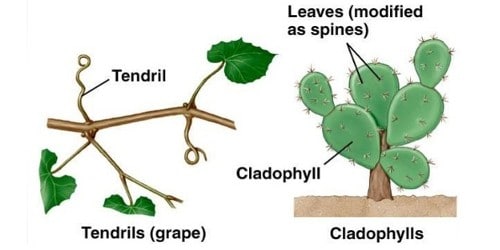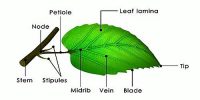Plants have changed themselves to adjust to their environment in exceptional ways. One of them is the modifications of leaves. Leaves are often modified to perform functions other than photosynthesis. The leaves of several plants get modified into different forms based on the plant’s purpose and environment. Leaf modifications are used to enhance the plant’s survival overall. It can result in enhancing the plant to be more attractive, trapping and digesting. They are converted into tendrils for climbing as in peas or into spines for defense as in cacti (Figure: a, b). The fleshy leaves of onion and garlic store food (Figure: c).

Fig: Modifications of leaf for: (a) support: tendril (h) protection: spines (c) storage: fleshy leaves
In some plants such as Australian acacia, the leaves are small and short-lived. The petioles in these plants expand, become green and synthesize food. Leaves of certain insectivorous plants such as pitcher plants, venus-fly trap are also modified leaves.
Spines – These leaves modified for protection. In most xerophytes (plants that grow in regions of scarce water) like Opuntia, the leaves are reduced to spines and the stem is modified into storage parts that store water for the plants.
Succulent Leaves – Some plants like Aloe vera have managed to grow fleshy leaves that serve as a storage part for water as well as reserve materials. The plants can survive for months without even a single drop of water and may turn brown.
Tendrils – In climbers, the leaf of plants would be modified into elongated structures to help the plants climb efficiently. Tendrils, of many plants, maybe up to 30 cm long, which makes them well suited for seeking support in the plant’s nearby environment.
Storage leaves – They are packed tightly into a flower pot like structure that catches falling water and debris. These leaves have large parenchymatous cells with a big central vacuole filled with hydrophilic colloid.














